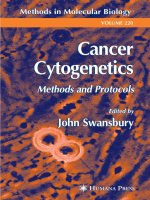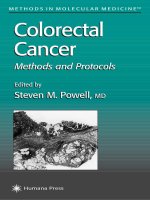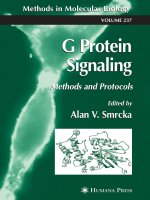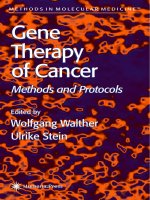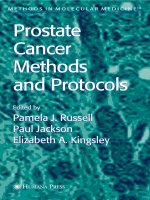Cancer Cell Signaling Methods and Protocols potx
Bạn đang xem bản rút gọn của tài liệu. Xem và tải ngay bản đầy đủ của tài liệu tại đây (3.9 MB, 349 trang )
HUMANA PRESS
Methods in Molecular Biology
TM
Edited by
David M. Terrian
Cancer Cell
Signaling
HUMANA PRESS
Methods in Molecular Biology
TM
VOLUME 218
Methods and Protocols
Edited by
David M. Terrian
Cancer Cell
Signaling
Methods and Protocols
Cancer Cell Signaling
M E T H O D S I N M O L E C U L A R B I O L O G Y™
John M. Walker, S
ERIES
E
DITOR
227. Membrane Transporters: Methods and Protocols, edited by
Qing Yan, 2003
226. PCR Protocols, Second Edition, edited by John M. S. Bartlett
and David Stirling, 2003
225. Inflammation Protocols, edited by Paul G. Winyard and
Derek A. Willoughby, 2003
224. Functional Genomics: Methods and Protocols, edited by
Michael J. Brownstein and Arkady Khodursky, 2003
223. Tumor Suppressor Genes: Volume 2: Regulation, Function,
and Medicinal Applications, edited by Wafik S. El-Deiry, 2003
222. Tumor Suppressor Genes: Volume 1: Pathways and Isolation
Strategies, edited by Wafik S. El-Deiry, 2003
221. Generation of cDNA Libraries: Methods and Protocols, ed-
ited by Shao-Yao Ying, 2003
220. Cancer Cytogenetics: Methods and Protocols, edited by John
Swansbury, 2003
219. Cardiac Cell and Gene Transfer: Principles, Protocols, and
Applications, edited by Joseph M. Metzger, 2003
218. Cancer Cell Signaling: Methods and Protocols, edited by
David M. Terrian, 2003
217. Neurogenetics: Methods and Protocols, edited by Nicholas
T. Potter, 2003
216. PCR Detection of Microbial Pathogens: Methods and Pro-
tocols, edited by Konrad Sachse and Joachim Frey, 2003
215. Cytokines and Colony Stimulating Factors: Methods and
Protocols, edited by Dieter Körholz and Wieland Kiess, 2003
214. Superantigen Protocols, edited by Teresa Krakauer, 2003
213. Capillary Electrophoresis of Carbohydrates, edited by
Pierre Thibault and Susumu Honda, 2003
212. Single Nucleotide Polymorphisms: Methods and Protocols,
edited by Pui-Yan Kwok, 2003
211. Protein Sequencing Protocols, 2nd ed., edited by Bryan John
Smith, 2003
210. MHC Protocols, edited by Stephen H. Powis and Robert W.
Vaughan, 2003
209. Transgenic Mouse Methods and Protocols, edited by Marten
Hofker and Jan van Deursen, 2003
208. Peptide Nucleic Acids: Methods and Protocols, edited by
Peter E. Nielsen, 2002
207. Recombinant Antibodies for Cancer Therapy: Methods and
Protocols. edited by Martin Welschof and Jürgen Krauss, 2002
206. Endothelin Protocols, edited by Janet J. Maguire and Anthony
P. Davenport, 2002
205. E. coli Gene Expression Protocols, edited by Peter E.
Vaillancourt, 2002
204. Molecular Cytogenetics: Protocols and Applications, edited
by Yao-Shan Fan, 2002
203. In Situ Detection of DNA Damage: Methods and Protocols,
edited by Vladimir V. Didenko, 2002
202. Thyroid Hormone Receptors: Methods and Protocols, edited
by Aria Baniahmad, 2002
201. Combinatorial Library Methods and Protocols, edited by
Lisa B. English, 2002
200. DNA Methylation Protocols, edited by Ken I. Mills and Bernie
H, Ramsahoye, 2002
199. Liposome Methods and Protocols, edited by Subhash C. Basu
and Manju Basu, 2002
198. Neural Stem Cells: Methods and Protocols, edited by Tanja
Zigova, Juan R. Sanchez-Ramos, and Paul R. Sanberg, 2002
197. Mitochondrial DNA: Methods and Protocols, edited by William
C. Copeland, 2002
196. Oxidants and Antioxidants: Ultrastructure and Molecular
Biology Protocols, edited by Donald Armstrong, 2002
195. Quantitative Trait Loci: Methods and Protocols, edited by
Nicola J. Camp and Angela Cox, 2002
194. Posttranslational Modifications of Proteins: Tools for Functional
Proteomics, edited by Christoph Kannicht, 2002
193. RT-PCR Protocols, edited by Joe O’Connell, 2002
192. PCR Cloning Protocols, 2nd ed., edited by Bing-Yuan Chen
and Harry W. Janes, 2002
191. Telomeres and Telomerase: Methods and Protocols, edited
by John A. Double and Michael J. Thompson, 2002
190. High Throughput Screening: Methods and Protocols, edited
by William P. Janzen, 2002
189. GTPase Protocols: The RAS Superfamily, edited by Edward
J. Manser and Thomas Leung, 2002
188. Epithelial Cell Culture Protocols, edited by Clare Wise, 2002
187. PCR Mutation Detection Protocols, edited by Bimal D. M.
Theophilus and Ralph Rapley, 2002
186. Oxidative Stress Biomarkers and Antioxidant Protocols, edited
by Donald Armstrong, 2002
185. Embryonic Stem Cells: Methods and Protocols, edited by
Kursad Turksen, 2002
184. Biostatistical Methods, edited by Stephen W. Looney, 2002
183. Green Fluorescent Protein: Applications and Protocols, edited
by Barry W. Hicks, 2002
182. In Vitro Mutagenesis Protocols, 2nd ed., edited by Jeff
Braman, 2002
181. Genomic Imprinting: Methods and Protocols, edited by
Andrew Ward, 2002
180. Transgenesis Techniques, 2nd ed.: Principles and Protocols,
edited by Alan R. Clarke, 2002
179. Gene Probes: Principles and Protocols, edited by Marilena
Aquino de Muro and Ralph Rapley, 2002
178. Antibody Phage Display: Methods and Protocols, edited by
Philippa M. O’Brien and Robert Aitken, 2001
177. Two-Hybrid Systems: Methods and Protocols, edited by Paul
N. MacDonald, 2001
176. Steroid Receptor Methods: Protocols and Assays, edited by
Benjamin A. Lieberman, 2001
175. Genomics Protocols, edited by Michael P. Starkey and
Ramnath Elaswarapu, 2001
174. Epstein-Barr Virus Protocols, edited by Joanna B. Wilson
and Gerhard H. W. May, 2001
173. Calcium-Binding Protein Protocols, Volume 2: Methods and
Techniques, edited by Hans J. Vogel, 2001
172. Calcium-Binding Protein Protocols, Volume 1: Reviews and
Case Histories, edited by Hans J. Vogel, 2001
171. Proteoglycan Protocols, edited by Renato V. Iozzo, 2001
170. DNA Arrays: Methods and Protocols, edited by Jang B.
Rampal, 2001
Cancer Cell
Signaling
Methods and Protocols
Edited by
David M. Terrian
Brody School of Medicine, East Carolina University, Greenville, NC
M E T H O D S I N M O L E C U L A R B I O L O G Y™
Humana Press Totowa, New Jersey
© 2003 Humana Press Inc.
999 Riverview Drive, Suite 208
Totowa, New Jersey 07512
www.humanapress.com
All rights reserved. No part of this book may be reproduced, stored in a retrieval system, or transmitted in
any form or by any means, electronic, mechanical, photocopying, microfilming, recording, or otherwise
without written permission from the Publisher. Methods in Molecular Biology™ is a trademark of The
Humana Press Inc.
The content and opinions expressed in this book are the sole work of the authors and editors, who have
warranted due diligence in the creation and issuance of their work. The publisher, editors, and authors are
not responsible for errors or omissions or for any consequences arising from the information or opinions
presented in this book and make no warranty, express or implied, with respect to its contents.
This publication is printed on acid-free paper. ∞
ANSI Z39.48-1984 (American Standards Institute) Permanence of Paper for Printed Library Materials.
Production Editor: Mark J. Breaugh.
Cover Illustration: In vitro characterization of the Rb–/–PrE cell line. See Fig. 6A,C on page 30.
Cover design by Patricia F. Cleary.
For additional copies, pricing for bulk purchases, and/or information about other Humana titles, contact
Humana at the above address or at any of the following numbers: Tel: 973-256-1699; Fax: 973-256-8341;
E-mail: , or visit our Website at www.humanapress.com
Photocopy Authorization Policy:
Authorization to photocopy items for internal or personal use, or the internal or personal use of specific
clients, is granted by Humana Press, provided that the base fee of US $20.00 per copy, is paid directly to the
Copyright Clearance Center at 222 Rosewood Drive, Danvers, MA 01923. For those organizations that have
been granted a photocopy license from the CCC, a separate system of payment has been arranged and is
acceptable to Humana Press Inc. The fee code for users of the Transactional Reporting Service is: [1-58829-
075-1/03 $20.00].
Printed in the United States of America. 10 9 8 7 6 5 4 3 2 1
Library of Congress Cataloging in Publication Data
Cancer cell signaling : methods and protocols / edited by David M. Terrian.
p. ; cm. (Methods in molecular biology ; 218)
Includes bibliographical references and index.
ISBN 1-58829-075-1 (alk. paper) 1-59259-356-9 (ebook)
1. Cancer cells Regulation Laboratory manuals. 2. Cellular signal
transduction Laboratory manuals. 3. Cancer Genetic aspects Laboratory manuals. I.
Terrian, David M. II. Methods in molecular biology (Clifton, N.J.) ; v. 218.
[DNLM: 1. Neoplasms physiopathology Laboratory Manuals. 2.
Neoplasms genetics Laboratory Manuals. 3. Signal
Transduction physiology Laboratory Manuals. QZ 25 C215 2003]
RC269.7 .C364 2003
616.99'407 dc21
2002027296
v
Preface
Cells respond to environmental cues through a complex and dynamic
network of signaling pathways that normally maintain a critical balance
between cellular proliferation, differentiation, senescence, and death. One
current research challenge is to identify those aberrations in signal transduc-
tion that directly contribute to a loss of this division-limited equilibrium and
the progression to malignant transformation. The study of cell-signaling mol-
ecules in this context is a central component of cancer research. From the
knowledge of such targets, investigators have been able to productively
advance many insightful hypotheses about how a particular cancer cell may
misinterpret, or respond inappropriately to, growth regulatory cues in their
environment. Despite these key insights, the rapidly evolving nature of cell
signaling research in cancer has necessitated a continuous revision of these
theoretical constructs and the updating of methods used in their study. One
contemporary example of the evolution of this field is provided by an analysis
of the Human Genome Project data, which reveal a previously unsuspected
diversity in the multigene families encoding for most signaling pathway inter-
mediates. In assessing the usefulness of a particular methodological approach,
therefore, we will need to keep in mind that there is a premium on those pro-
tocols that can be easily adapted for the analysis of multiple members within a
gene family. Cancer Cell Signaling: Methods and Protocols brings together
several such methods in cell signaling research that are scientifically grounded
within the cancer biology field. The first part of this volume is generally
concerned with methods and techniques for the investigation of apoptosis and
cell death. The second part contains a complementary set of protocols for
manipulating and/or monitoring oncogenic signals in cancer cells. In the third,
methods for studying protein–protein interactions are covered. Finally, in part
four, there is a detailed protocol for capturing pure samples of malignant cells
from frozen tissue specimens and two alternative techniques for analyzing
their genomic DNA.
I thank the authors for providing such clear and detailed accounts of
their experimental protocols and for the many useful hints they have gener-
ously included in the notes to each chapter.
David M. Terrian
Contents
Preface
v
Contributors
xi
PART I. MANIPULATION AND DETECTION OF SURVIVAL SIGNALS
1 Functional Analysis of the Antimitogenic Activity
of Tumor Suppressors
Erik S. Knudsen and Steven P. Angus 3
2 Rescue and Isolation of
Rb
-deficient Prostate Epithelium
by Tissue Recombination
Simon W. Hayward, Yuzhuo Wang, and Mark L. Day 17
3 Signal Transduction Study Using
Gene-Targeted Embryonic Stem Cells
Hideki Kawasome, Takashi Hamazaki, Tetsuo Minamino,
and Naohiro Terada 35
4 The Use of the Yeast Two-Hybrid System to Measure
Protein–Protein Interactions that Occur Following Oxidative Stress
Richard A. Franklin 47
5 Differential Screening of cDNA Libraries for Analysis
of Gene Expression During Tumor Progression
Christopher W. Gregory 59
6 Mitogen-Activated Protein Kinase Signaling
in Drug-Resistant Neuroblastoma Cells
Raymond R. Mattingly 71
7 TUNEL and Immunofluorescence Double-Labeling Assay
for Apoptotic Cells with Specific Antigen(s)
Stephanie M. Oberhaus 85
PART II. MANIPULATION AND DETECTION OF ONCOGENIC SIGNALS
8 Kinetworks
TM
Protein Kinase Multiblot Analysis
Steven Pelech, Catherine Sutter, and Hong Zhang 99
9 Protein Tyrosine Kinase and Phosphatase Expression Profiling
in Human Cancers
Wen-Chang Lin 113
vii
viii Contents
10 Association of Nonreceptor Tyrosine Kinase
c
-Yes with Tight Junction
Protein Occludin by Coimmunoprecipitation Assay
Yan-Hua Chen and Qun Lu 127
11 Isolation of Novel Substrates Using a
Tyrosine Kinase Overlay/
In Situ
Assay
Irwin H. Gelman 133
12 Manipulating Expression of Endogenous Oncogenic Proteins
Using an Antisense Oligonucleotide Approach
in Prostate Cancer Cells
Daqing Wu, Ginger G. Wescott, and David M. Terrian 143
13 Measurements of Phospholipases A
2
, C, and D (PLA
2
, PLC, and PLD):
In Vitro Microassays, Analysis of Enzyme Isoforms,
and Intact-Cell Assays
Julian Gomez-Cambronero, Joel Horwitz,
and Ramadan I. Sha’afi 155
14 Detection of the Content and Activity of the Transcription Factor
AP-1 in a Multistage Skin Carcinogenesis Model
Yunfeng Zhao and Daret K. St. Clair 177
15 Fibroblastic, Hematopoietic, and Hormone Responsive
Epithelial Cell Lines and Culture Conditions for Elucidation
of Signal Transduction and Drug Resistance Pathways
by Gene Transfer
Linda S. Steelman, William L. Blalock, Xiao-Yang Wang,
Phillip W. Moye, John T. Lee, John G. Shelton,
Patrick M. Navolanic, Julianne M. Davis, Steven L. Knapp,
Richard A. Franklin, Martyn K. White,
and James A. McCubrey 185
16 Elucidation of Signal Transduction Pathways by Transfection
of Cells with Modified Oncogenes
Linda S. Steelman, William L. Blalock, Xiao-Yang Wang,
Phillip W. Moye, John T. Lee, John G. Shelton,
Patrick M. Navolanic, Julianne M. Davis, Steven L. Knapp,
Richard A. Franklin, Martyn K. White,
and James A. McCubrey 203
17 Elucidation of Signal Transduction Pathways by Retroviral Infection
of Cells with Modified Oncogenes
Linda S. Steelman, William L. Blalock, Xiao-Yang Wang,
Phillip W. Moye, John T. Lee, John G. Shelton,
Patrick M. Navolanic, Julianne M. Davis, Steven L. Knapp,
Richard A. Franklin, Martyn K. White,
and James A. McCubrey 221
Contents ix
PART III. PROTEIN INTERACTIONS
18 Methods for the Study of Protein–Protein Interactions
in Cancer Cell Biology
Daniel Price, Iha Park, and Hava Avraham 255
19 Production of Ligand-Specific Mutants
Using a Yeast Two-Hybrid Mating Assay
André Nantel 269
20 Coimmunoprecipitation Assay for the Detection
of Kinase–Substrate Interactions
Lucio Comai 277
PART IV. GENOMIC REARRANGEMENTS
21 Mutational Analysis of the Androgen Receptor Using Laser Capture
Microdissection and Direct Sequencing
Sheila Greene, Patricia Stockton, Olga G. Kozyreva,
Kris E. Gaston, Gordon P. Flake, and James L. Mohler 287
22 Clonality Analysis by T-Cell Receptor γ PCR
and High-Resolution Electrophoresis
in the Diagnosis of Cutaneous T-Cell Lymphoma (CTCL)
Ansgar Lukowsky 303
Index
321
xi
Contributors
STEVEN P. ANGUS • Department of Cell Biology, Vontz Center for Molecular
Studies, University of Cincinnati College of Medicine, Cincinnati, OH
HAVA AVRAHAM • Division of Experimental Medicine, Beth Israel-Deaconess
Medical Center, Harvard Medical School, Boston, MA
WILLIAM L. BLALOCK • Shands Cancer Center, University of Florida,
Gainesville, FL
YAN-HUA CHEN • Department of Anatomy and Cell Biology, Brody School
of Medicine at East Carolina University, Greenville, NC
LUCIO COMAI • Department of Molecular Microbiology and Immunology, Keck
School of Medicine, University of Southern California, Los Angeles, CA
JULIANNE M. DAVIS • Department of Biology, East Carolina University,
Greenville, NC
MARK L. DAY • Department of Urology, University of Michigan Comprehensive
Cancer Center, Ann Arbor, MI
GORDON P. FLAKE • Laboratory of Experimental Pathology, National Institute
of Environmental Health Sciences, Research Triangle Park, NC
RICHARD A. FRANKLIN • Department of Microbiology and Immunology, Brody
School of Medicine at East Carolina University, Greenville, NC
KRIS E. GASTON • Division of Urology, Department of Surgery
and UNC-Lineberger Comprehensive Cancer Center, University of North
Carolina at Chapel Hill, Chapel Hill, NC
IRWIN H. GELMAN • Department of Medicine, Division of Infectious Diseases
and Ruttenberg Cancer Center, Mount Sinai School of Medicine,
New York, NY
JULIAN GOMEZ-CAMBRONERO • Department of Physiology and Biophysics,
Wright State University School of Medicine, Dayton, OH
SHEILA GREENE • Division of Urology, Department of Surgery, University
of North Carolina at Chapel Hill, Chapel Hill, NC
CHRISTOPHER W. GREGORY • Department of Pathology and Laboratory Medicine,
University of North Carolina at Chapel Hill, Chapel Hill, NC
TAKASHI HAMAZAKI • Department of Pathology, University of Florida College
of Medicine, Gainesville, FL
xii Contributors
SIMON W. HAYWARD • Department of Urologic Surgery, Department of Cancer
Biology, Vanderbilt-Ingram Comprehensive Cancer Center, Vanderbilt
Prostate Cancer Center, Vanderbilt University Medical Center, Nashville, TN
JOEL HORWITZ • Department of Pharmacology and Physiology, MCP
Hahnemann University, Philadelphia, PA
HIDEKI KAWASOME • Otsuka Pharmaceutical Co. Ltd, Tokushima, Japan
STEVEN L. KNAPP • Department of Microbiology and Immunology, Brody
School of Medicine at East Carolina University, Greenville, NC
ERIK S. KNUDSEN • Department of Cell Biology, Vontz Center for Molecular
Studies, University of Cincinnati College of Medicine, Cincinnati, OH
OLGA G. KOZYREVA • Division of Urology, Department of Surgery, University
of North Carolina at Chapel Hill, Chapel Hill, NC
JOHN T. LEE • Department of Microbiology and Immunology, Brody School
of Medicine at East Carolina University, Greenville, NC
WEN-CHANG LIN • Institute of Biomedical Sciences, Academia Sinica, Taipei,
Taiwan
QUN LU • Department of Anatomy and Cell Biology, Brody School of Medicine
at East Carolina University, Greenville, NC
ANSGAR LUKOWSKY • Humboldt University, Medical Faculty (Charité),
Department of Dermatology and Allergy, Berlin, Germany
RAYMOND R. MATTINGLY • Department of Pharmacology, Wayne State
University, Detroit, MI
JAMES A. MCCUBREY • Department of Microbiology and Immunology, Brody
School of Medicine at East Carolina University, Greenville, NC
TETSUO MINAMINO • Department of Internal Medicine and Therapeutics, Osaka
University Graduate School of Medicine, Osaka, Japan
JAMES L. MOHLER • Division of Urology, Department of Surgery
and UNC-Lineberger Comprehensive Cancer Center, University
of North Carolina at Chapel Hill, Chapel Hill, NC
PHILLIP W. MOYE • Department of Microbiology and Immunology, Brody
School of Medicine at East Carolina University, Greenville, NC
ANDRÉ NANTEL • Biotechnology Research Institute, National Research Council,
Montreal, PQ, Canada
PATRICK M. NAVOLANIC • Department of Microbiology and Immunology, Brody
School of Medicine at East Carolina University, Greenville, NC
STEPHANIE M. OBERHAUS • Department of Microbiology and Immunology,
Brody School of Medicine at East Carolina University, Greenville, NC
IHA PARK • Division of Experimental Medicine, Beth Israel-Deaconess
Medical Center and Harvard Medical School, Boston, MA
Contributors xiii
STEVEN PELECH • Department of Medicine, University of British Columbia,
Vancouver, BC, Canada
D
ANIEL PRICE • Division of Experimental Medicine, Beth Israel-Deaconess
Medical Center and Harvard Medical School, Boston, MA
RAMADAN I. SHA’AFI • Department of Physiology, University of Connecticut
Health Center, Farmington, CT
JOHN G. SHELTON • Department of Microbiology and Immunology, Brody
School of Medicine at East Carolina University, Greenville, NC
DARET K. ST. CLAIR • Graduate Center for Toxicology, University of Kentucky,
Lexington, KY
LINDA S. STEELMAN • Department of Microbiology and Immunology, Brody
School of Medicine at East Carolina University, Greenville, NC
PATRICIA STOCKTON • Laboratory of Experimental Pathology, National Institute
of Environmental Health Sciences, Research Triangle Park, NC
CATHERINE SUTTER • Kinexus Bioinformatics Corporation, Vancouver, BC,
Canada
NAOHIRO TERADA • Department of Pathology, University of Florida College of
Medicine, Gainesville, FL
DAVID M. TERRIAN • Department of Anatomy and Cell Biology, Brody School of
Medicine at East Carolina University, Greenville, NC
XIAO-YANG WANG • BD Biosciences Clontech, Palo Alto, CA
YUZHUO WANG • Department of Cancer Endocrinology, BC Cancer Agency,
Vancouver, BC, Canada
GINGER G. WESCOTT • Department of Anatomy and Cell Biology, Brody School
of Medicine at East Carolina University, Greenville, NC
MARTYN K. WHITE • Department of Pathology, Anatomy and Cell Biology,
Thomas Jefferson College of Medicine, Philadelphia, PA
DAQING WU • Department of Anatomy and Cell Biology, Brody School of
Medicine at East Carolina University, Greenville, NC
HONG ZHANG • Department of Medicine, University of British Columbia,
Vancouver, BC, Canada
YUNFENG ZHAO • Graduate Center for Toxicology, University of Kentucky,
Lexington, KY
Antimitogenic Activity of Tumor Suppression 1
I
MANIPULATION
AND
DETECTION OF SURVIVAL SIGNALS
2 Knudsen and Angus
Antimitogenic Activity of Tumor Suppression 3
1
Functional Analysis of the Antimitogenic
Activity of Tumor Suppressors
Erik S. Knudsen and Steven P. Angus
3
From:
Methods in Molecular Biology, vol. 218: Cancer Cell Signaling: Methods and Protocols
Edited by: D. M. Terrian © Humana Press Inc., Totowa, NJ
Abstract
Loss of tumor suppressors contributes to numerous cancer types. Many, but
not all, proteins encoded by tumor suppressor genes have antiproliferative activ-
ity and halt cell-cycle progression. In this chapter, we present three methods
that have been utilized to monitor the antimitogenic action exerted by tumor
suppressors. Tumor suppressor function can be demonstrated by colony for-
mation assays and acquisition of the flat-cell phenotype. Because of the anti-
proliferative action of these agents, we also present two transient assays that
monitor the effect of tumor suppressors on cell-cycle progression. One is
based on BrdU incorporation (i.e., DNA replication) and the other on flow
cytometry. Together, this triad of techniques is sufficient to determine the
action of tumor suppressors and other antiproliferative agents.
Key Words: Tumor suppressor; green fluorescent protein; bromo-deoxy-
uridine; retinoblastoma; cell cycle; cyclin; flow cytometry; mitogen; fluo-
rescence microscopy.
1. Introduction
The discovery of tumor suppressor genes, whose loss predisposes to tumor
development, has revolutionized the molecular analysis of cancer (1–3). By def-
inition, tumor suppressor genes are genetically linked to a cancer. For example,
the retinoblastoma (RB) tumor suppressor was first identified as a gene that
was specifically lost in familial RB (4–6). The majority of tumor suppressors
4 Knudsen and Angus
has been identified based on linkage analysis and subsequent epidemiological
studies, however, initial understanding of their mode of action was relatively
limited. As the number of tumor suppressors has increased, understanding the
mechanism through which tumor suppressors function has become an important
aspect of cancer biology.
In general, tumors exhibit uncontrolled proliferation. This phenotype can
arise from loss of tumor suppressors that regulate progression through the cell
cycle (e.g., RB or p16ink4a) or upstream mitogenic signaling (e.g., NF1 or PTEN)
cascades (1,3,7–9). Thus, specific tumor suppressors can function to suppress pro-
liferation. However, not all tumor suppressors act in this manner. For example,
mismatch repair factors (e.g., MSH2 or MLH-1) lost in hereditary nonpolyposis
colorectal cancer (HNPCC) function not to inhibit proliferation, but to prevent
further mutations (10–12). Additionally, other tumor suppressors have multi-
ple functions, for example, p53 can function to either induce cell death or halt
cell-cycle progression (9,13).
Functional analysis of tumor suppressors relies on a host of methods to deter-
mine how or if they inhibit proliferation. Later, we will focus on methods that
have been used to assess the antimitogenic potential of the RB-pathway (2,3,7,
14). However, these same approaches are amenable to any tumor suppressor or
antimitogenic molecule.
Assays used to evaluate antimitogenic activity are based either on the halt of
proliferation or cell-cycle progression. Cell proliferation assays, as described
later, have been extensively utilized to demonstrate the antiproliferative effect
of tumor suppressors (15–20). However, these assays do not illuminate whether
the observed effects are attributable to cell-cycle arrest or apoptosis. Addition-
ally, because of the antiproliferative action of many tumor suppressors, it is
difficult to obtain sufficient populations of cells for analysis. This obstacle can
be surmounted through the use of transient assays to monitor cell-cycle effects
(16,19,21–25). Two different transient approaches to analyze tumor suppressor
action on the cell cycle are also described.
2. Materials
2.1. Cell Culture and Transfection
of Antimitogen/Tumor Suppressor
1. SAOS-2 human osteosarcoma cell line (ATCC #HTB-85).
2. Dulbecco’s modification of Eagle’s medium (DMEM, Cellgro, cat #10-017-CV)
supplemented with 10% heat-inactivated fetal bovine serum (FBS, Atlanta Bio-
logicals, cat #S12450), 100 U/mL penicillin-streptomycin and 2 mM L-glutamine
(Gibco-BRL).
Antimitogenic Activity of Tumor Suppression 5
3. Dulbecco’s phosphate-buffered saline (PBS), tissue culture grade, without calcium
and magnesium (Cellgro, cat #21-031-CV).
4. 1X Trypsin-EDTA solution (Cellgro, cat #25-052-CI).
5. 60-mm tissue-culture dishes.
6. Six-well tissue-culture dishes.
7. 12-mm circular glass cover slips (Fisher), sterilized.
8. Mammalian expression system (e.g., pcDNA3.1, Invitrogen).
9. Relevant cDNAs: RB, Histone 2B (H2B)-GFP [from G. Wahl, The Salk Institute,
La Jolla, CA (26)], pBABE-puro [puromycin resistance plasmid, (27)].
10. 0.25M CaCl
2
: dissolve in ddH
2
O; filter (0.2 µm) sterilize and store in aliquots at
−20ºC.
11. 2X BES-buffered solution (2X BBS): 50 mM N,N-bis (2-hydroxyethyl)-2-amino-
ethanesulfonic acid, 280 mM NaCl, 1.5 mM Na
2
HPO
4
, adjust pH to 6.95 in ddH
2
O,
filter (0.2 µm) sterilize and store in aliquots at −20ºC.
12. Inverted fluorescence microscope (Zeiss).
2.2. Inhibition of BrdU
Incorporation in Transiently-Transfected Cells
1. Transfected SAOS-2 cells.
2. Cell proliferation-labeling reagent, BrdU/FdU (Amersham Pharmacia, cat# RPN201).
3. PBS: 136 mM NaCl, 2.6 mM KCl, 10mM Na
2
HPO
4
, 2.7 mM KH
2
PO
4
in ddH
2
O;
pH to 7.4 with HCl; sterilize in autoclave.
4. 3.7% (v/v) formaldehyde in PBS: dilute fresh from 37% w/w stock solution (Fisher).
5. 0.3% (v/v) Triton X-100 (Fisher) in PBS.
6. Immunofluorescence (IF) buffer: 0.5% v/v Nonidet P-40 (Fisher) and 5 mg/mL
(w/v) bovine serum albumin (Sigma) in PBS; store at 4ºC.
7. 1M MgCl
2
.
8. DNase I, RNase-free (10 U/µL) (Roche, cat# 776 785).
9. Monoclonal rat anti-BrdU antibody (Accurate Scientific, cat #YSRTOBT-0030).
10. Donkey anti-rat IgG, Red X-conjugated (Jackson Immunoresearch, cat #712-295-
153).
11. 1 mg/mL (w/v) Hoechst 33258 (Sigma, cat #B2883).
12. Microscope slides.
13. Gel/Mount (Biomeda Corp., cat #MØ1)
14. Inverted fluorescence microscope (Zeiss).
2.3. Cell-Cycle Analysis of Transiently-Transfected Cells
1. Transfected SAOS-2 cells.
2. PBS.
3. 1X Trypsin-ethylene diamine tetraacetic acid (EDTA) solution (Cellgro, cat #25-
052-CI).
4. Clinical centrifuge.
6 Knudsen and Angus
5. 100% ethanol stored at −20ºC.
6. 40 mg/mL (w/v) RNase A (Sigma, cat #R-4875): Dissolve in sterile double-dis-
tilled (dd)H
2
O at 100ºC, 15 min; aliquot and store at −20ºC.
7. 100X propidium iodide (PI) solution: 20 mg/mL (w/v) propidium iodide (Sigma,
cat #P-4170) in PBS; cover with foil to protect from light and store at 4ºC.
8. 5-mL polystyrene round-bottom tubes (Becton Dickinson, cat #35-2058).
9. Coulter Epics XL flow cytometer.
10. FlowJo data analysis software (Treestar).
11. ModFit cell-cycle analysis software (Verity).
2.4. Flat-Cell Assay and Colony
Inhibition in Stably-Transfected Cells
1. Transfected SAOS-2 cells.
2. 2.5 mg/mL puromycin (w/v) (Sigma, cat #P-7255).
3. 1% crystal violet (w/v) (Fisher, cat #C581-25)/20% ethanol solution.
4. Inverted microscope with camera.
3. Methods
3.1. Cell Culture and Transfection
of Antimitogen/Tumor Suppressor
3.1.1. Cell Culture
1. Seed approx 1 × 10
5
cells per well of a six-well plate or 3 × 10
5
cells per 60-mm
dish in DMEM supplemented with 10% FBS and penicillin-streptomycin.
2. SAOS-2 cells should attach to the tissue culture dish within 4–6 h.
3.1.2. Cell Transfection
1. Prepare purified plasmid DNA stocks at 1 mg/mL concentration in TE buffer.
2. Add DNA to 1.5-mL Eppendorf tube (4.25 µg per well of a six-well plate, 8.5 µg
total per 60-mm dish).
3. Add 0.25M CaCl
2
to DNA and mix by pipeting.
4. Add 2X BBS solution and mix by inverting.
5. Incubate tubes at room temperature for 20 min.
6. Add DNA/CaCl
2
/BBS solution to cells dropwise.
7. Inspect the cells for the presence of precipitate using an inverted microscope (20×
power is sufficient) (see Note 1).
8. Return cells to tissue culture incubator (37ºC, 5% CO
2
).
9. 16 h postaddition of precipitate, wash cells three times briefly with PBS.
10. Inspect dishes to ensure removal of precipitate.
11. Add fresh media to cells.
Antimitogenic Activity of Tumor Suppression 7
3.1.3. Confirmation of Transfection/
Determining Transfection Efficiency
1. Take live plates of cells transfected 16 h prior with H2B-GFP and either vector or
antimitogen/tumor suppressor out of the incubator.
2. Aspirate media.
3. Replace with PBS.
4. Visualize transfected cells by GFP fluorescence using an inverted fluorescent micro-
scope (20X power is sufficient).
5. Using the GFP fluorescence and phase contrast, determine the percentage of GFP-
positive cells by counting random fields of cells.
6. Compare the relative transfection efficiencies between vector control and antimito-
gen/tumor suppressor.
3.2. Inhibition of BrdU
Incorporation in Transiently Transfected Cells
3.2.1. Cell Culture
1. Culture cells at 60% confluence (approx 1 × 10
5
cells/well) on coverslips in a six-
well plate (four cover slips per well).
3.2.2. Cell Transfection
1. Use 4 µg of CMV-vector or CMV-RB and 0.25 µg of CMV-H2B-GFP.
2. Use 0.125 mL CaCl
2
and 0.125 mL 2X BBS.
3.2.3. BrdU Labeling
1. 36–48 h after adding fresh media to transfected cells, add cell proliferation-label-
ing reagent directly to media in wells (1:1000 dilution) (see Note 2).
2. Return six-well dish to tissue-culture incubator for 16 h.
3.2.4. Fixation
1. Aspirate media from wells.
2. Wash cells gently with PBS.
3. Fix cells at room temperature with 3.7% formaldehyde in PBS for 15 min.
4. Aspirate formaldehyde.
5. Add PBS to wells.
6. Cover slips in PBS may be stored in dark at 4ºC.
3.2.5. BrdU Staining
1. Aspirate PBS.
2. Add 0.3% Triton X-100 in PBS to wells to permeabilize the cells (see Note 3).
3. Incubate dish at room temperature for 15 min.
4. Aspirate 0.3% Triton X-100 and replace with PBS.
8 Knudsen and Angus
5. Prepare primary antibody solution by diluting the following in IF buffer:
a. 1:50 1M MgCl
2
.
b. 1:500 Rat anti-BrdU.
c. 1:500 DNase I (see Note 4).
6. Pipet 35 µL primary antibody solution onto each cover slip.
7. Incubate cover slips in a humidified chamber at 37ºC for 45 min (see Fig. 1).
8. Wash cover slips in PBS in six-well dish for 5 min with 2–3 changes.
9. Prepare secondary antibody solution by diluting the following in IF buffer:
a. 1:100 Donkey anti-rat Red-X.
b. 1:100 Hoechst (10 µg/mL final conc.).
10. Pipet 35 µL secondary antibody solution onto each cover slip.
11. Incubate cover slips in humidified chamber at 37ºC for 45 min.
12. Wash cover slips in PBS in six-well dish for 5 min with 2–3 changes.
13. Mount cover slips on slides using Gel/Mount.
14. Examine cover slips using an inverted fluorescence microscope.
15. Inhibition determined by counting.
Fig. 1. Diagram of BrdU staining in a humidified chamber of fixed and permeabil-
ized cells grown on glass cover slips.
Antimitogenic Activity of Tumor Suppression 9
3.2.6. Quantitation and Documentation
1. Quantitation of BrdU inhibition.
a. Count the number of transfected (i.e., GFP-positive) cells in a random field).
b. Without changing fields, count the number of GFP-positive cells that are also
BrdU-positive (i.e., Red-X-positive).
c. Repeat steps a and b until 150–200 GFP-positive cells have been counted.
d. Calculate the percent BrdU-positive (BrdU-positive/GFP-positive).
e. As a control, determine the percentage of BrdU-positive cells from
untransfected (GFP-negative) cells on the same cover slips.
f. Compare the effect of antimitogen expression vs vector expression on BrdU incor-
poration (see Fig. 2).
2. Documentation
a. Take representative photomicrographs of selected fields.
b. Use blue (Hoechst), green (H2B-GFP), and red (Red-X) channels to obtain
photomicrographs of the same field.
3.3. Cell-Cycle Arrest in Transiently-Transfected Cells
3.3.1. Cell Culture
1. Culture cells in 60-mm dishes at 60% confluence.
2. Include a dish that will not be transfected.
3.3.2. Cell Transfection
1. Use 8 µg of CMV-vector or CMV-RB and 0.5 µg of CMV-H2B-GFP (see Note 5).
2. Use 0.25 mL CaCl
2
and 0.25 mL 2X BBS.
Fig. 2. SAOS-2 cells were cotransfected with H2B-GFP and either CMV-vector or
CMV-RB. Cells were pulse-labeled with BrdU for 16 h. Fixation, permeabilization,
and immunostaining were performed as described. Photomicrographs of immunofluo-
rescent cells were taken at equal magnification. Arrows indicate transfected cells. Quanti-
fication of this approach is presented in refs. (19,21–23).
10 Knudsen and Angus
3.3.3. Cell Harvesting and Fixation
1. 36–48 h after adding fresh media to transfected cells, add trysin (approx 0.75 mL)
to dishes.
2. Confirm that cells have detached after 1–2 min using inverted microscope.
3. Inactivate trypsin by adding an equal volume of media.
4. Transfer suspended cells to 15-mL conical tubes.
5. Pellet cells in a clinical centrifuge at 1000 rpm, 2–3 min.
6. Aspirate media.
7. Add 2–3 mL PBS to wash cell pellet.
8. Repeat centrifugation.
9. Aspirate PBS.
10. Resuspend cell pellet in 200 µL PBS.
11. Slowly add 1 mL ice-cold 100% ethanol while vortexing gently.
12. Tubes may be stored in the dark at 4ºC for 1–2 wk.
3.3.4. Propidium Iodide Staining
1. Prepare 1X PI by diluting 100X PI stock solution in PBS (see Note 6).
2. Add RNase A to 1X PI at a 1:1000 dilution (final concentration = 40 µg/mL).
3. Pellet fixed cells at 200g, 2–3 min.
4. Aspirate ethanol.
5. Resuspend cell pellet in approx 1 mL 1X PI containing RNase A.
6. Transfer resuspended cells to 5-mL polystyrene round-bottom tubes.
7. Incubate tubes in the dark at room temperature for at least 15 min prior to analysis
(see Note 7).
3.3.5. FACS
1. Run untransfected control to set background levels of GFP signal and to establish
PI parameters.
2. Gate H2B-GFP-positive cells (either positive or negative) (see Fig. 3 and Note 8).
3. Analyze PI staining in GFP-positive cells.
4. Perform ModFit analysis on PI histograms (see Fig. 3).
3.4. Flat-Cell Assay/Colony
Inhibition in Stably Transfected Cells
3.4.1. Cell Culture
1. Culture 1 × 10
5
cells in 60-mm dishes.
2. Include a control plate that will not be transfected.
3.4.2. Cell Transfection
1. Use 8 µg of CMV-vector or CMV-RB and 0.5 µg of pBABE-puro.
2. Use 0.25 mL CaCl
2
and 0.25 mL 2X BBS.




